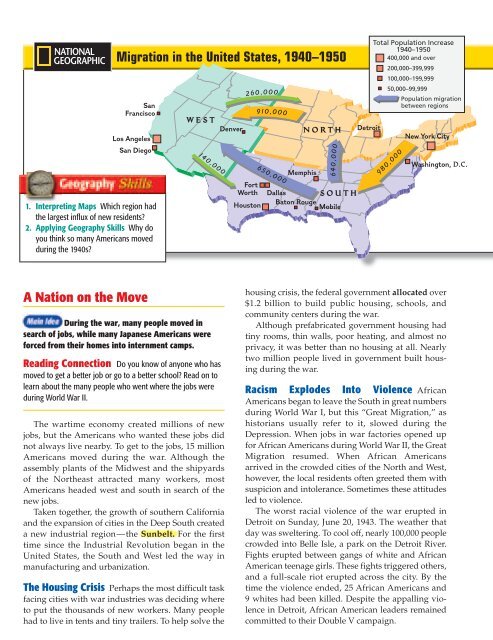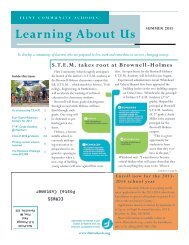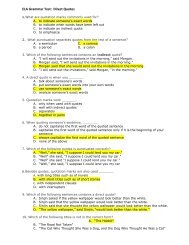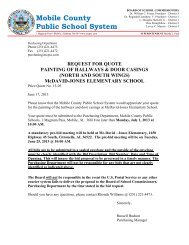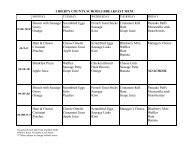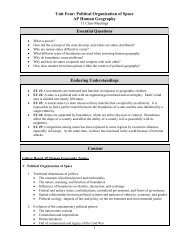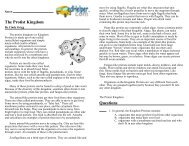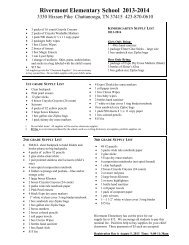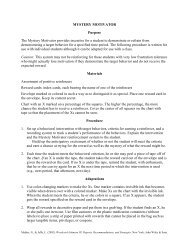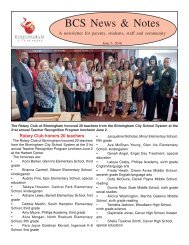Chapter 12: America and World War II, 1941-1945 - Georgia ...
Chapter 12: America and World War II, 1941-1945 - Georgia ...
Chapter 12: America and World War II, 1941-1945 - Georgia ...
Create successful ePaper yourself
Turn your PDF publications into a flip-book with our unique Google optimized e-Paper software.
Migration in the United States, 1940–1950<br />
San<br />
Francisco<br />
Los Angeles<br />
San Diego<br />
1. Interpreting Maps Which region had<br />
the largest influx of new residents?<br />
2. Applying Geography Skills Why do<br />
you think so many <strong>America</strong>ns moved<br />
during the 1940s?<br />
WEST<br />
140,000<br />
Denver<br />
260,000<br />
Fort<br />
Worth<br />
Houston<br />
910,000<br />
650,000<br />
Memphis<br />
NORTH<br />
640,000<br />
Dallas SOUTH<br />
Baton Rouge<br />
Mobile<br />
Detroit<br />
Total Population Increase<br />
1940–1950<br />
400,000 <strong>and</strong> over<br />
200,000–399,999<br />
100,000–199,999<br />
50,000–99,999<br />
Population migration<br />
between regions<br />
980,000<br />
New York City<br />
Washington, D.C.<br />
A Nation on the Move<br />
During the war, many people moved in<br />
search of jobs, while many Japanese <strong>America</strong>ns were<br />
forced from their homes into internment camps.<br />
Reading Connection Do you know of anyone who has<br />
moved to get a better job or go to a better school? Read on to<br />
learn about the many people who went where the jobs were<br />
during <strong>World</strong> <strong>War</strong> <strong>II</strong>.<br />
The wartime economy created millions of new<br />
jobs, but the <strong>America</strong>ns who wanted these jobs did<br />
not always live nearby. To get to the jobs, 15 million<br />
<strong>America</strong>ns moved during the war. Although the<br />
assembly plants of the Midwest <strong>and</strong> the shipyards<br />
of the Northeast attracted many workers, most<br />
<strong>America</strong>ns headed west <strong>and</strong> south in search of the<br />
new jobs.<br />
Taken together, the growth of southern California<br />
<strong>and</strong> the expansion of cities in the Deep South created<br />
a new industrial region—the Sunbelt. For the first<br />
time since the Industrial Revolution began in the<br />
United States, the South <strong>and</strong> West led the way in<br />
manufacturing <strong>and</strong> urbanization.<br />
The Housing Crisis Perhaps the most difficult task<br />
facing cities with war industries was deciding where<br />
to put the thous<strong>and</strong>s of new workers. Many people<br />
had to live in tents <strong>and</strong> tiny trailers. To help solve the<br />
housing crisis, the federal government allocated over<br />
$1.2 billion to build public housing, schools, <strong>and</strong><br />
community centers during the war.<br />
Although prefabricated government housing had<br />
tiny rooms, thin walls, poor heating, <strong>and</strong> almost no<br />
privacy, it was better than no housing at all. Nearly<br />
two million people lived in government built housing<br />
during the war.<br />
Racism Explodes Into Violence African<br />
<strong>America</strong>ns began to leave the South in great numbers<br />
during <strong>World</strong> <strong>War</strong> I, but this “Great Migration,” as<br />
historians usually refer to it, slowed during the<br />
Depression. When jobs in war factories opened up<br />
for African <strong>America</strong>ns during <strong>World</strong> <strong>War</strong> <strong>II</strong>, the Great<br />
Migration resumed. When African <strong>America</strong>ns<br />
arrived in the crowded cities of the North <strong>and</strong> West,<br />
however, the local residents often greeted them with<br />
suspicion <strong>and</strong> intolerance. Sometimes these attitudes<br />
led to violence.<br />
The worst racial violence of the war erupted in<br />
Detroit on Sunday, June 20, 1943. The weather that<br />
day was sweltering. To cool off, nearly 100,000 people<br />
crowded into Belle Isle, a park on the Detroit River.<br />
Fights erupted between gangs of white <strong>and</strong> African<br />
<strong>America</strong>n teenage girls. These fights triggered others,<br />
<strong>and</strong> a full-scale riot erupted across the city. By the<br />
time the violence ended, 25 African <strong>America</strong>ns <strong>and</strong><br />
9 whites had been killed. Despite the appalling violence<br />
in Detroit, African <strong>America</strong>n leaders remained<br />
committed to their Double V campaign.<br />
CHAPTER <strong>12</strong> <strong>America</strong> <strong>and</strong> <strong>World</strong> <strong>War</strong> <strong>II</strong> 589


